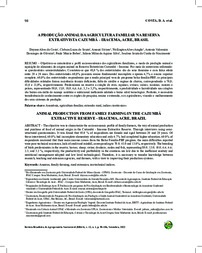A produção animal da agricultura familiar na Reserva Extrativista Cazumbá-Iracema, Acre, Brasil.
A produção animal da agricultura familiar na Reserva Extrativista Cazumbá-Iracema, Acre, Brasil.
Author(s): COSTA, D.; SOUZA, C. L. de; SIVIERO, A.; ARAGÃO, W. A.; OLIVEIRA, A. V. D. de; BEBER, P. M.; SILVA, J. M. de A.; NASCIMENTO, J. S. da C. do
Summary: Objetivou-se caracterizar o perfil socioeconômico dos agricultores familiares, o modo de produção animal e aquisição de alimentos de origem animal na Reserva Extrativista Cazumbá - Iracema. Por meio de entrevistas utilizando-se questionários semi estruturados. Constatou-se que 48,0 % dos entrevistados são do sexo feminino e com faixa etária entre 20 e 29 anos. Dos entrevistados 60,0% possuem ensino fundamental incompleto e apenas 6,7% o ensino superior completo; 60,0% dos entrevistados responderam que a renda principal vem do programa bolsa família-PBF; as principais dificuldades relatadas foram assistência técnica deficiente, falta de crédito e regime de chuvas, correspondendo a 70,0; 43,0 e 13,0%, respectivamente. Predominam na reserva a criação de aves; equinos; ovinos; suínos; asininos; muares e peixes, representando 80,0; 13,0; 10,0; 6,6; 6,6; 3,3 e 3,3%, respectivamente, a produtividade e lucratividade nas criações são baixas em razão do manejo sanitário e nutricional ineficiente adotado e baixo nível tecnológico. Portanto, é necessário transferência de conhecimentos entre os órgãos de pesquisa, ensino e extensão, e os agricultores, visando o melhoramento dos seus sistemas de produção. The objective was to characterize the socioeconomic profile of family farmers, the way of animal production and purchase of food of animal origin in the Cazumbá - Iracema Extractive Reserve. Through interviews using semistructured questionnaires. It was found that 48.0 % of respondents are female and aged between 20 and 29 years. Of those interviewed, 60.0% had incomplete elementary education and only 6.7% had completed higher education; 60.0% of respondents answered that their main income comes from the Bolsa Família-PBF program; the main difficulties reported were poor technical assistance, lack of credit and rainfall, corresponding to 70.0; 43.0 and 13.0%, respectively. The breeding of birds predominates in the reserve; horses; sheep; swine; donkeys; mules and fish, representing 80.0; 13.0; 10.0; 6.6; 6.6; 3.3; and 3.3 %, respectively, the productivity and profitability in the creations are low due to the inefficient sanitary and nutritional management adopted and low level technological. Therefore, it is necessary to transfer knowledge between research, teaching and extension agencies, and farmers, with a view to improving their production systems.
Publication year: 2022
Types of publication: Journal article
Unit: Embrapa Acre
Keywords: Acre, Agricultura Familiar, Agricultural research, Amanzonia Occidental, Amazônia Ocidental, Animal production, Aplicação de questionários, Conservation areas, Cuestionarios, Desarrollo socioeconómico, Entrevistas, Explotación agrícola familiar, Extensão Rural, Family farms, Interviews, Investigación agraria, Manuel Urbano (AC), Perfil socioeconômico, Pesquisa Agrícola, Producción animal, Produção Animal, Questionnaires, RESEX Cazumbá-Iracema, Sena Madureira (AC), Socioeconomic development, Unidade de conservação, Western Amazon, Áreas de conservación
Observation
Some of Embrapa's publications are published as ePub files. To read them, use or download one of the following free software options to your computer or mobile device. Android: Google Play Books; IOS: iBooks; Windows and Linux: Calibre.
Access other publications
Access the Agricultural Research Database (BDPA) to consult Embrapa's full library collection and records.
Visit Embrapa Bookstore to purchase books and other publications sold by Embrapa.

